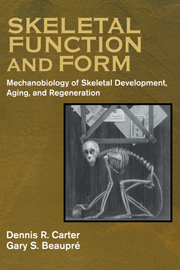
-
Select format
-
- Publisher:
- Cambridge University Press
- Publication date:
- January 2010
- December 2000
- ISBN:
- 9780511574993
- 9780521790000
- 9780521714754
- Dimensions:
- (253 x 177 mm)
- Weight & Pages:
- 0.85kg, 332 Pages
- Dimensions:
- (253 x 177 mm)
- Weight & Pages:
- 0.587kg, 332 Pages
- Subjects:
- Life Sciences, Engineering, Bioengineering, Biomedical Engineering
You may already have access via personal or institutional login- Subjects:
- Life Sciences, Engineering, Bioengineering, Biomedical Engineering
Book description
The intimate relationship between form and function inherent in the design of animals is perhaps nowhere more evident than in the musculoskeletal system. In the bones, cartilage, tendons, ligaments, and muscles of all vertebrates there is a graceful and efficient physical order. This book is about how function determines form. It addresses the role of mechanical factors in the development, adaptation, maintenance, ageing and repair of skeletal tissues. The authors refer to this process as mechanobiology and develop their theme within an evolutionary framework. They show how the normal development of skeletal tissues is influenced by mechanical stimulation beginning in the embryo and continuing throughout life into old age. They also show how degenerative disorders such as arthritis and osteoporosis are regulated by the same mechanical processes that influence development and growth. Skeletal Function and Form bridges important gaps among disciplines, providing a common ground for understanding, and will appeal to a wide audience of bioengineers, zoologists, anthropologists, palaeontologists and orthopaedists.
Reviews
‘… readers with an interest in skeletal form and function will gain new understanding of the possible roles of physical forces in skeletal tissue processes … and will be drawn to wonder about the physical, biological, and evolutionary mechanisms responsive for skeletal tissue function and form.’
Richard T. Hart Source: Journal of Biomechanics
‘… this book is a comprehensive synopsis of the mechanobiology of the skeleton extended and updated with many rigorous analytical models …’
David Green Source: The Times Higher Education Supplement
‘This excellent book is a comprehensive introduction to the study of the modulation of bone form and function by mechanical stimuli. This is an informative and enjoyable book … A recommended read for graduate studies in biology and orthopaedics as well as for practising orthopaedic surgeons.’
David Green Source: The Times Higher Education Supplement
'As a vertebrate palaeobiologist interested in animal design and function from a number of perspectives I was interested to read this book. Overall it is a masterly treatment of the subject … has its place on library shelves and in the offices of genuine specialists.'
Source: Journal of the Geological Magazine
‘… there is much that is interesting and thought-provoking in the book.’
Source: International Journal of Osteoarchaeology
Contents
Metrics
Altmetric attention score
Full text views
Full text views help Loading metrics...
Loading metrics...
* Views captured on Cambridge Core between #date#. This data will be updated every 24 hours.
Usage data cannot currently be displayed.
Accessibility standard: Unknown
Why this information is here
This section outlines the accessibility features of this content - including support for screen readers, full keyboard navigation and high-contrast display options. This may not be relevant for you.
Accessibility Information
Accessibility compliance for the PDF of this book is currently unknown and may be updated in the future.


